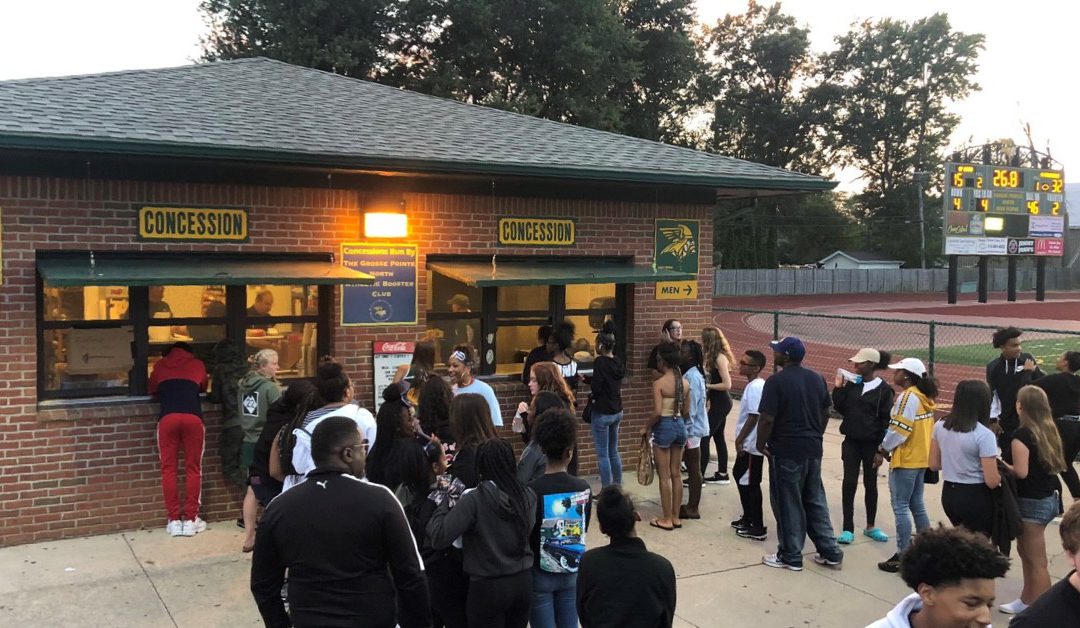It doesn’t matter if you’ve been part of a booster club for many years or it’s your first day on the job, there are some common pitfalls that we’ve seen across boosters nationwide. And we’ve learned so much about booster practices over the years by being in the high school concession space.
We love helping booster clubs succeed, and we love playing a part in their fundraising projects. Be it through our technology, our resources, our sponsorship support or our partnership with organizations like NBCTC and state athletic associations, we very much enjoy sharing with booster clubs around the country what we’ve learned along the way.
Having worked with 50+ high schools nationwide and talked to countless others, today we’d like to take a look at the most common mistakes we’ve seen so far and how to avoid them in your day-to-day operations.
1. Working separately from other booster clubs
It’s common for many booster clubs to be heads down in the program they are in charge of and never touch on other programs in the school. For example, a basketball booster may not work with the football booster and they each operate independently. While that might have simplified the accounting process and eliminated the need for coordination, it could be preventing you from reaching your booster club’s full fundraising potential. Opening your booster club up to the involvement of parents and supporters outside your group can lead to more manpower, resources, ideas and even funding.
For example, a football booster could ask cheerleaders and the band to take part in their fundraising activities and reach a wider audience. Other tips include “trading” shifts with other boosters. Especially if members of your booster club aren’t available for all shifts at a particular event, you could “borrow” people from other boosters and return the favor at their future fundraising events.
Oftentimes when different booster clubs constantly communicate and share resources/information, it benefits everyone. Some of our partner booster clubs using FanFood to streamlines their concession operations would refer another booster club from the same school, and receive a cash reward in return.
Or they could share the same FanFood kit and split the cost — that way the booster club only pays half the price for FanFood while enjoying the full benefits that mobile ordering brings!
2. Not gaining the tax exempt 501(c)(3) status
It’s estimated that only 12% of booster clubs have taken the steps to register and become tax exempt organizations. That means they are forfeiting the right to gain donor contributions with a tax benefit. As a result, they fail to capture additional fundraising revenue.
Filing for 501(c)(3) sounds like a tedious process, but there are several ways to go about doing that. If you are DIYing the process, you can file under an umbrella organization such as Parent Booster USA. In the IRS code, an umbrella organization can cover multiple nonprofit licenses under one institutional permit, which means you’re sharing the nonprofit status with other booster clubs.
If your school is already a nonprofit, which is very likely, you can get your booster club approved as an official body of the school and not have to go through the process of certifying as a 501(c)(3). The downside of this is that the money made through your booster club would belong to your school as well. In that case, you may have less freedom in how you can spend the fundraising revenue, or even worse, more restrictions in the purchase order process (we all know what a nightmare procedures and protocols can be).
Also, the plus side is that you don’t have to start acting like a nonprofit only after your 501(c)(3) is approved. As long as you’ve submitted your application to the IRS, you can start fundraising like a 501(c)(3).
3. Not establishing standardized accounting policies and procedures
An overwhelming 90% of booster clubs reported that they had not formally established any accounting policies and procedures. Booster club theft is a very common occurrence, especially when the procedures aren’t well-established, and no checks and balances are in place. Just think about how many thefts have gone undetected because there’s a lack of supervision over the handling of funds (and it gets worse when all funds exist in the form of cash, which could get lost without a trace 😱).
The good news is there are plenty of websites and softwares for easy accounting, even if you have no idea where to begin. Quickbooks is one such software, which offers a non-profit accounting program that can be easily customized for your booster club. You can build in policies that instruct: how to make deposits, how to issue checks, what are acceptable and non-acceptable expenses, how to make reimbursement requests, how to handle petty cash etc. Everyone in the booster club can refer to this as the guidebook for all finance and accounting purposes.
An even easier solution would be to promote cashless transactions in your community. This way all transactions are handled securely in the background and don’t have to go through the hands of anyone. This keeps your club members focused on fundraising and not be distracted by cumbersome paperwork. FanFood’s mobile ordering app acts as the cashless point-of-sale system on everyone’s phone, meaning they can pay in-app and all you have to pay attention to is the reporting dashboard at the end of an event, with all the sales and transaction numbers you need to care about.
Booster club presidents who work with us often say that the reporting dashboard is their favorite feature of FanFood:”At the end of the day, I know exactly how much I sold, who I sold it too and when I sold them.”
4. Maintaining a collaborative relationship with school administrators and coaches
The collaboration between the booster club and school admin can take many forms. At the minimum, it’s helpful for the AD or coach (whoever is in charge of the particular program) to define a clear fundraising goal based on what the school needs — be it new equipment, student programs, or other areas that would require money. This way booster clubs can plan the scope of their fundraising activities and budget accordingly.
It’s encouraged that booster clubs sit with the school’s administrators and coaches to establish a plan of action, and brainstorm how they can support each other. We’ve found that schools where the ADs care deeply about what the booster clubs are doing (sometimes they even refer their booster presidents to FanFood’s resources and services!) tend to see the most success, and the tightest community presence.
Sometimes the ADs and coaches can even personally take part in the fundraising activities. In our 23 best fundraising ideas, one is “Release the Hostage”. You can invite the AD or the coach to be the “hostage”, and people have to donate money until the amount required for a “bail” is reached.
5. Not keeping in contact with friends, alumni and business supporters
A successful booster club isn’t just great at operating concession stands. It’s also a unifying force within the community that brings people together: students, parents, players, faculty, alumni, local businesses…In the long run, this helps with the booster club’s fundraising efforts as well. After all, the bigger your audience is, the more contributions you get to receive.
And it’s not difficult to maintain consistent communication with all these stakeholders either. You can develop a monthly newsletter and send it to current and past supporters. Start a Facebook page, as well as a Twitter and Instagram account and post content regularly, sharing game updates, students participating in activities and holiday messages. It won’t be hard to find a student who’s proficient at this and want to gain more experience in communications.
We want to particularly emphasize the importance of maintaining communications with local businesses. You never know, someday they may become important sponsors/donors to your projects! Some of our partner high schools have been able to secure thousands of dollars in sponsorship money with the assets that FanFood provides. If you want to learn more about our sponsorship offering and ask us to help you find sponsors, please reach out to us and we’d be happy to talk to you about it.
To see a full demo and other capabilities on FanFood, fill out the form below to get in touch with our team!

